Vickers Wellington Mk.XIII (MP.705)
-
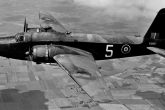
Vickers Wellington Aircraft -
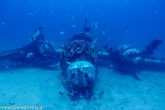
The Vickers Wellington Mk.XIIΙ (MP. 705) in the sea bottom near Chrisopigi in Sifnos. We can see the front part of the fuselage and the two machine guns of the aircraft. (© Archive Antonis Grafas) -
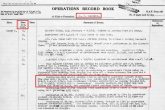
The input of the loss of Vickers Wellington Mk.XIIΙ (MP. 705) in the Operation Record Book of the 38th RAF Squadron. (TNA AIR 27/400) -
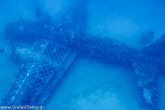
The left part of Vickers Wellington Mk.XIIΙ (MP. 705). (© Archive Antonis Grafas) -
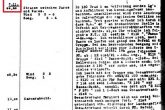
The input of the fight in the war diary of the German antisubmarine UJ-2102 on 07.11.1943 that had as a result the dropping of Vickers Wellington Mk.XIIΙ (MP. 705). (NARA) -
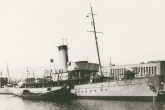
UJ-2102 (ex BRIGITTE) in autumn 1943 at the port of Piraeus. (© Archive Dimitri Galon) -
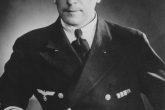
The captain of UJ-2102, Lieuteant Gero Kleiner. (© Archive Alex Shenec) -

Vickers Wellington Mk.XIIΙ (MP. 705) viewed from the back part of the fuselage. (© Archive Antonis Grafas) -
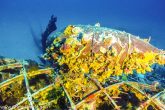
The aircraft’s radar covered with benthos. (© Archive Antonis Grafas) -
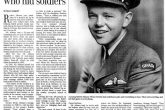
The pilot's funeral ( Robert Adams ) in the Canadian newspaper the Globe and mail. Saturday March 2003 -

The documentary for the Canadian television titled “This song belongs to freedom” -

Documentary The wings of hope
Vickers Wellington Mk.XIIΙ Aircraft (MP.705)
On June 25th 2017, the team of Antonis Grafas dived near the area of Chrisopigi in Sifnos island where, with its own means, the assistance of a local fisherman and the support of Sifnos Diving Center, it detected anew a Vickers Wellington, type Mk.XIIΙ aircraft that was hit by the German firing during the night of November 7th 1943 having as a result its emergency ditching at the south-east area of Sifnos. The wreck of the aircraft, which was detected after war by some local fishermen and their information on this wreck assisted the Air Force to detect its exact location, was first researched in 2014 by a 6-member team of Greek divers under the directions of Mr. Nikos Vassilatos.
The Vickers Wellington was a British twin-engined aircraft used by the British Royal Air Force during the World War II to many battlefronts as a bomber, minelayer, scout plane and antisubmarine. Its construction started in 1936 and continued until 1945. More than 11,000 aircrafts of this type were constructed and the general technical characteristics of the basic model were the below:
Type: Bomber and antisubmarine aircraft of medium range
Constructor: Vickers-Armstrongs Ltd.
Length: 19,69m
Span (the length from the edge of the left to the edge of the right blade): 26,27m
Height: 5,31m
Blade surface: 78,1 sq.m
Weight (when empty): 8.435 kilos
Maximum weight of take-off: 12.955 kilos
Engines: 2 x Bristol Pegasus (the Mk.XIII type had 2 x Hercules XVII of 1.735 hp)
Power: 1.050 hp each
Maximum speed: 378 km/hour
Autonomy: 4.106 km
Maximum height: 5.490m
Crew: 6 persons
Indicative armament: 6 to 8 Browning machine guns (7,62 x 63mm) and capacity of transferring torpedoes and bombs.
The History of Vickers Wellington Mk.XIII (MP.705)
On November 5th 1943, almost two months after the Italian convention and while the claim of the islands of Dodecanese between the German and the allied forces was ongoing, thirteen landing ships (Pionier-Landungsboote), two locomotive (Pionier-Führungsboote) and eight J-Boote accompanied by two costguard (R-Boote), three offshore guards (GA-Boote) and two antisubmarine (UJ-Boote) departed from Porto Rafti and Lavrio. This was a convoy of the German War Navy (Kriegsmarine) that had as a direct operational target the transfer of parts of the 10th Air Corps to Dodecanese (X. Fliegerkorps). The convoy had the code name “Operation Leopard” (in German was Unternehmen Leopard) and had as an indirect target the enhancement of the guard and the airports of the recently taken by the German army islands of Rodos and Kos. One of the two escort antisubmarine ships was the UJ-2102 (ex BRIGITTE, 437 gross tonnage owned by the Greek industrialist Evgenidis) that was directed by the Lieutenant Gero Kleiner and that, almost one year earlier, on November 16th 1942, had sunk near the cape of Kafireas (Evoia) the Greek royal submarine TRITON (captain Epaminondas Kontogiannis). The convoy would pass from Cyclades where it would be enhanced with ships from the Kriegsmarine from Syros, it would continue through the strait of
Paros-Naxos towards Amorgos in order to then follow a direction to Dodecanese. On November 7th 1943, the convoy underwent several attacks by the Allied forces at the area of Paros-Naxos. The most severe one was the attack of the British destroyers HMS PENN and HMS PATHFINDER that managed to sank the German ship GA 45 (ex Eleni S.). After the attackes, the convoy was forced to retreat and get shelter at the bay of Naoussa and Marmara in Paros. While it was waiting there though, it was ordered to continue its course towards Amorgos, while two German MFP landing crafts (Marinefährpram) and six Pionier-Landungsboote were ordered, under the administration of UJ-2102 (Kptlt. Gero Kleiner), to head towards the port of Naxos where arrived and anchored in the afternoon of the same day.On the exact same day, a British Vickers Wellington Mk.XIIΙ aircraft of the 38th Corps of RAF with code MP.705 and a 6-member crew consisted of the Canadian Flight Lieutenant Robert (Bob) Watson Adams (J/12210 RCAF, pilot), Arthur John Spencer (133746 RAFVR, co pilot), the Australian Sgt. Travers Kilfera Falkiner (AUS400701 RAAF, bombardier) and the gunners F/Sgt. D. Broome (1030902 RAF), Sgt. J. B. Farrell (1268415) and Sgt. W. Trowbridge (1163901), took off at 20.00pm from Berka in Libya in order to complete the operation that had as a target to create a minefield at the entrance of the port of Naxos. The aircraft that arrived to Naxos at 22.00pm started the creation of the minefield at the entrance of the port.
While it had already placed 16 mines and the operation was ongoing, due to lack of wind and the vivid moonlight, it was acknowledged by the German antisubmarine UJ-2102 that along with the rest German ships started a strong firing against the aircraft. Vickers Wellington was shot at the right blade and the engine and as a result it adandoned the area with a south west direction and realized later on an emergency ditching at the south east area of Sifnos, near Chrisopigi. All passengers were rescued, managed to reach the coast using the lifeboat of the aircraft and, after receiving the huge assistance by the residents of Sifnos, they managed to escape and go to England safe in the middle of December 1943. In 1966, the pilot of Vickers Wellington, the Canadian Flight Lieutenant Robert (Bob) Watson Adams, returned back to Sifnos with his wife where he met again the locals who assisted him and his men during the days they had stayed on the island. From this meeting the documentary of Antonis Troulos for the Canadian television named “ This song belongs to freedom” was created.
The Wreck
The wreck of Vickers Wellington Mk.XIIΙ (MP. 705) is located with the bottom part of its fuselage on a flat, sandy sea bottom of 75m while the axis of the aircraft has a north direction. The fuselage, the blades, the engines and all the rest parts of the aircraft are still united without any obvious crack or any significant damage. The right engine has remainings of a net on it and the rest fuselage remains clear from any fish tools. On its upper part, the ASV Mk. II radar and the radio antenna are well covered with benthos but they are still obvious. The machine guns of the front chamber are on their position, turned to the bottom and touching the sea bottom. The intense inclination of the propellers affirms that the engines of the aircraft were moving during the ditching. The outside cover of the fuselage does not exist anymore so that we can clearly see the geometrical outside framework of the aircraft and sometimes its inner part too. This is a particularly well reserved Vickers Wellington in a good situation that, due to its participation in the fights for the claim of Dodecanese, is one of the few discovered historical witnesses of the World War II in the sea bottom of the Aegean Sea.
DG
Sources:
Koronewski, Evan: Spokesperson, Media Relations Office, Department of National Defence / Government of Canada
ORB 38 RAF Squadron (TNA AIR 27/400)
KTB der 21. UJ-Flottille (NARA)
KTB des kommandierenden Admiral Ägäis
Levogiannis, Nikos I.: Modern History of Naxos 1800 – 2000, Athens 2017
Archive of Manolis Bardanis
Newspaper Eleftheros Tipos, July 5th 2014
Pitchford, Graham: “Shot Down and On the Run” The RCAF and Commonwealth aircrews who got home from behind enemy lines, 1940-1945, edit. The Dundurn Group, Toronto 2003
“This song belongs to freedom”: Documentary of Antonis G. Troulou for the Canadian television

